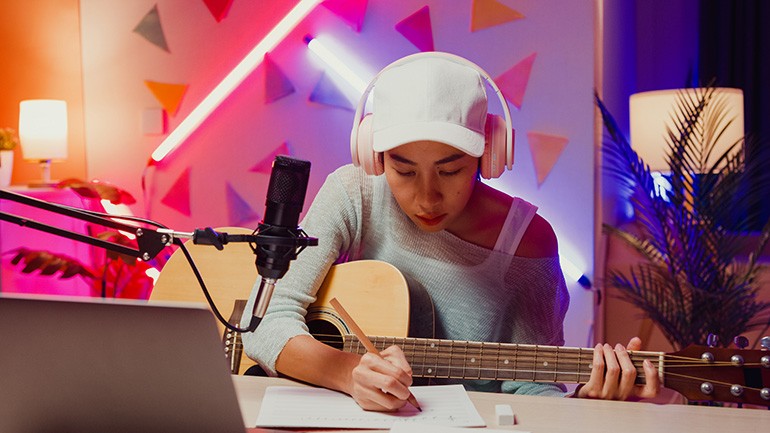Which Point of View Is Best For Your Song

I’m often asked which point of view is the strongest for songs. Point of view, which is sometimes referred to as the narrative perspective, determines whether the singer is sharing his or her own story and feelings; telling someone else’s story and feelings; or acting as an impartial narrator. Let’s look at the primary options.
First Person
Lyrics written from the first-person perspective are told from the viewpoint of the singer. The singer is a character in the story. This allows the listener to experience the events described in the song through the eyes and heart of the singer. The audience is privy to what the singer thinks and feels because the singer reveals his or her feelings.
The pronouns used when writing from the first-person point of view include “I,” “me,” “we,” “my,” “mine,” and “us.”
Lyrics written from the first-person perspective might include lines such as:
- I’d do anything to get you back
- I’m sick and tired of the hatred in this world
- We stayed up all night laughing
Examples of songs written from the first-person perspective include Donna Fargo’s self-penned Country Music Association’s Song of the Year, “I’m the Happiest Girl in the Whole U.S.A.” and “Bam Bam” (written by Cheche Alara, Edgar Barrera, Camila Cabella, Eric Frederic, Scott Harris, and Ed Sheeran; recorded by Camila Cabella featuring Ed Sheeran).
Second Person
Lyrics written from the second person point of view directly address the character being sung about. The singer (or writer) purports to know the thoughts, feelings, and actions of the person about which he or she is singing and states what “you” do, say, or feel.
The pronouns used when writing from the second person point of view include “you,” “your,” and “yours.”
Here are some examples of lyrics written from the second person perspective:
- You’d do anything to get me back
- You’re sick and tired of the hatred in this world
- You stayed up all night laughing
Songs written from the second person perspective are rare, but some of them have enjoyed tremendous success. Country music classic, “Your Cheatin’ Heart” (written and recorded by Hank Williams) and ABBA’s iconic “Dancing Queen” (written by Stig Anderson, Benny Andersson, and Björn Ulvaeus) are prime examples.
Although it does not typically work well to mix points of view in the same song, the verses of Charlie Puth’s international smash, “Attention” (written by Charlie Puth and Jacob Hindlin) are written from the first-person point of view, while the choruses effectively use the second person perspective.
Third Person
In lyrics written from the third person perspective, the singer is a narrator—an omniscient observer who relates a story. The singer is not a character in the story.
The pronouns used when writing from the third person point of view include “he,” “she,” “it,” and “they.” The narrator (i.e., the singer or the writer) might also address a character by his or her name.
Here are some examples of lyrics written from the third person perspective:
- She’d do anything to get him back
- They say they’re sick and tired of the hatred in this world
- Johnny stayed up all night laughing
Songs written from the third person point of view include the Beatles’ “Eleanor Rigby” (written by John Lennon and Sir Paul McCartney) and Kenny Chesney’s “Everyone She Knows” (written by Ross Copperman, Shane McAnally, and Josh Osborne).
The majority of songs are written from the first-person perspective. It conveys immediacy and is often used in love songs because it allows the writer to directly express his or her feelings, such as, “I love you,” to the person he or she is addressing. The second person narrative is rarely used, but can be an effective way to ascribe traits, actions, and feelings to a character in a song. It can be effective in protest songs and in songs that seek to tell how someone else feels. Third-person perspective affords the writer an opportunity to tell a story that he or she is not part of. It allows the writer a chance to make a point or express his or her feelings about a topic or issue without owning those feelings as his or her own. The downside is that this perspective can distance the listener.
So, which point of view is best for your song? There is no definitive answer. Iconic songs have been written from each of the main perspectives discussed in this article. The decision needs to be made on a case-by-case basis, dependent on what you feel will best serve each song. Each point of view has its unique advantages and disadvantages.
A special thank you to Judy Klass, Rick “Sudi” Karatas, Mark Thomas, Silje Haavet Golden, and all of my Facebook friends who suggested song examples.
Jason Blume is the author of 6 Steps to Songwriting Success, This Business of Songwriting, and Inside Songwriting (Billboard Books). His songs are on Grammy-nominated albums and have sold more than 50,000,000 copies. A guest lecturer at the Liverpool Institute for Performing Arts (co-founded by Sir Paul McCartney) and at the Berklee School of Music, he has been interviewed as a songwriting expert for CNN, NPR, the BBC, Rolling Stone, and the New York Times. To receive a free video, “3 Things You MUST Do for Success” and weekly tips to enhance creativity click on https://tinyurl.com/yckat6fc. Join Songwriting With Jason Blume on Facebook for free events and song critiques. For information about his workshops, webinars, additional articles, and more, visit www.jasonblume.com.






Community
Connect with BMI & Professional Songwriters